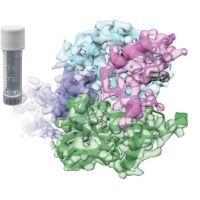Specification
| Organism | Homo sapiens (Human) |
| Expression Host | E.coli |
| Tag Info | N-terminal 6xHis-tagged |
| Purity | Greater than 85% by SDS-PAGE |
| Uniprot ID | Q96MG7 |
| Gene Names | NSMCE3 |
| Alternative Names | Hepatocellular carcinoma-associated protein 4 MAGE-G1 antigen Melanoma-associated antigen G1 Necdin-like protein 2 |
| Expression Region | Full Length(1-304aa ) |
| Molecular Weight | 38.4 kDa |
| Protein Sequence | MLQKPRNRGRSGGQAERDRDWSHSGNPGASRAGEDARVLRDGFAEEAPSTSRGPGGSQGSQGPSPQGARRAQAAPAVGPRSQKQLELKVSELVQFLLIKDQKKIPIKRADILKHVIGDYKDIFPDLFKRAAERLQYVFGYKLVELEPKSNTYILINTLEPVEEDAEMRGDQGTPTTGLLMIVLGLIFMKGNTIKETEAWDFLRRLGVYPTKKHLIFGDPKKLITEDFVRQRYLEYRRIPHTDPVDYEFQWGPRTNLETSKMKVLKFVAKVHNQDPKDWPAQYCEALADEENRARPQPSGPAPSS |
| Form | Liquid or Lyophilization |
| Buffer | The default storage buffer is Tris/PBS-based buffer, 5%-50% glycerol if the delivery form is liquid. The lyophilization buffer is Tris/PBS-based buffer, 6% Trehalose, pH 8.0 if the delivery form is lyophilized powder. Please contact us if you have any special requirment. |
| Reconstitution | Please reconstitute protein in deionized sterile water and we recommend that briefly centrifuge thevial prior to opening the vial .We recommend aliquot for long-term storage at -20℃/-80℃. |
Background
| Relevance | Component of the SMC5-SMC6 complex, a complex involved in repair of DNA double-strand breaks by homologous recombination (PubMed:20864041, PubMed:27427983). The complex may promote sister chromatid homologous recombination by recruiting the SMC1-SMC3 cohesin complex to double-strand breaks. The complex is required for telomere maintenance via recombination in ALT (alternative lengthening of telomeres) cell lines and mediates sumoylation of shelterin complex (telosome) components which is proposed to lead to shelterin complex disassembly in ALT-associated PML bodies (APBs). In vitro enhances ubiquitin ligase activity of NSMCE1. Proposed to act through recruitment and/or stabilization of the Ubl-conjugating enzyme (E2) at the E3:substrate complex (PubMed:20864041). May be a growth suppressor that facilitates the entry of the cell into cell cycle arrest (By similarity). |
| Involvement in Disease | |
| Subcellular Location | |
| Protein Families | |
| Tissue Specificity | NSMCE3 |
QC Data
| Note | Please contact us for QC Data |
| Product Image (Reference Only) |  |

